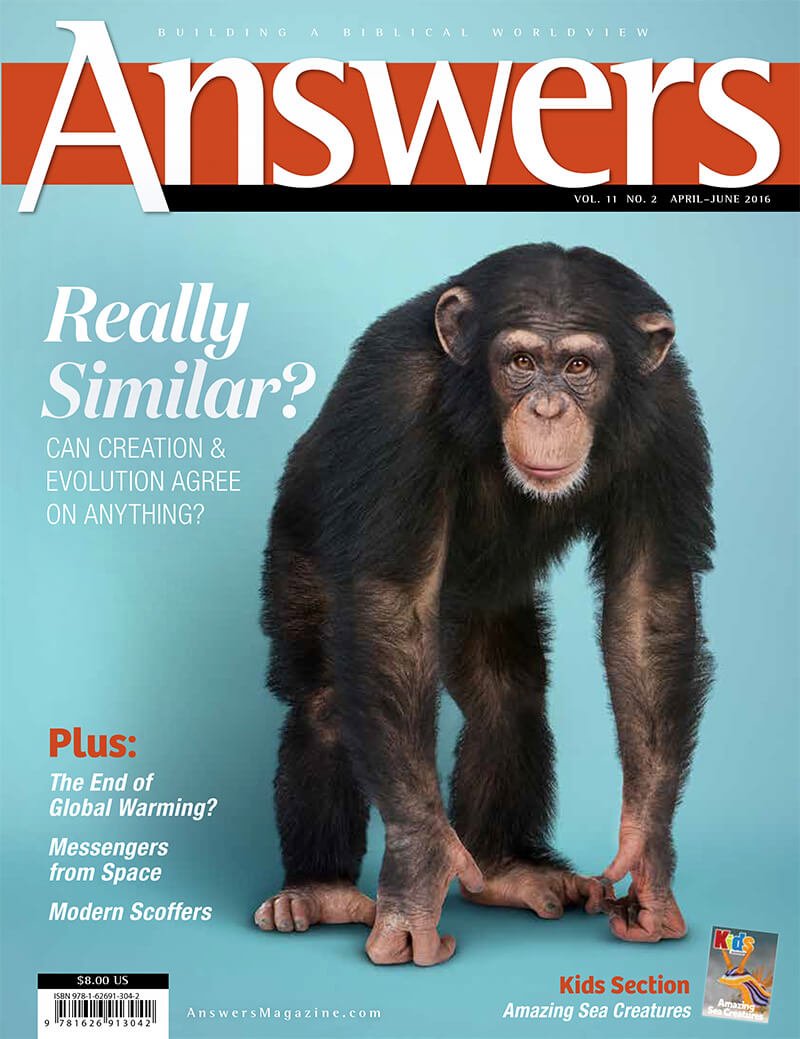
Readers Respond to Answers, January–March, 2016
Ark Anguish
The article by Mike Belknap and Tim Chaffey (“Reimagining Ark Animals”) caused me some anguish because it sounded like all the “just so stories” from evolutionists. How could a tiger, for example, appear from a mating of the cat kind depicted in the article?
Deborah C., Longwood, Florida
Editor’s Response: Creationists and evolutionists agree that animals change, sometimes drastically (look at dogs, for example). The distinction between creation and evolution lies in at least three considerations about that change:
- Extent—Evolution says change is limited only by time. Creation says change is limited to a created kind.
- Time—Evolution says millions of years are available. Creation says any changes must have happened rapidly.
- Driving Force—Evolution holds that animals change through random mutation over millions of generations. Creation claims God designed animals to adapt to their environment.
Evolution involves change that is random, slow, and unlimited. Creation involves change that is purposeful, relatively fast, and limited—by design—within a prescribed range, even if it sometimes appears drastic.
Seeing Snowflakes
I was excited to read Larry Vardiman’s article, “Snowflakes—The Patron’s Gift.” If you are interested in seeing the beauty of snowflakes, get a magnifying glass and observe some on your coat sleeve or car windshield.
To do your own snowflake photography, get a digital camera that has a super macro setting. Try catching snowflakes on a piece of glass and experiment with backlighting. Do your work in an unheated garage or shed and dress warm. You will be amazed at the photos you can get.
Steven J., Burbank, Pennsylvania
A Horse Is a Horse
In the Kids section of the January–March issue, the Mesohippus is given as an ancestor of the modern horse. That sounds like the typical evolutionary mantra. What evidence is there of such a relationship between the small three-toed animal and Equus caballus? Couldn’t Mesohippus have just been an odd kind by itself?
Janet W., DVM, Middlesex, New York
Author’s Response: On the surface, the idea that the tiny Mesohippus and large modern equids belong to separate created “kinds” seems reasonable. On the other hand, the skull and teeth of Mesohippus and similar fossils in the horse family (Equidae) exhibit characteristics unique to equids. There’s presently no way of verifying whether Equus descended directly from Mesohippus or from one of the other horse varieties but the presence of these defining features identifies all these equid species as expressions of the same “kind.”
Concerning smaller size and multiple toes, hundreds of fossils consistently confirm these as common attributes of early equids. Size increases in the Northern Hemisphere made good metabolic sense to endure the Ice Age, since larger animals can retain body heat better. Regarding the number of toes, certain equids—like the large, modern-looking Dinohippus—had both one- and three-toed individuals within the same species! So body size and number of toes can vary greatly, even within a species (let alone the larger created “kind”). This would not be evolution but variation within a kind.
Reinforcing the Bible’s Authority
Thanks, Answers, for another great issue. “Do Creationists Change?” and “How to Myth-interpret the Bible” by Ken and Steve Ham are superb. They really help to keep Christians focused on biblical authority.
Larry M., Lewisburg, Ohio
What’s in a Name?
I received the Jan.–March 2016 issue about two weeks ago and, with college starting back up, I read only a few articles. “Bruce or Caitlyn . . . What’s in a Name?” gave me a beautiful perspective, but I certainly didn’t know I would need it within the coming weeks.
I found out last night that one of my friends is transgender, and I have been struggling with anger at Satan and my friend. Sifting through my disappointment, I remembered Corey Abney’s beautiful article and reread it.
God is who I will be focusing on as I interact with my friend. God will receive glory even in the yuck. Thank you for your prayed-over articles . . . they are making such a difference.
Soli Deo gloria!
Sarah H., Lincoln, Nebraska
Are Trees Alive?
Dr. Don DeYoung’s article “Why Not a Square Tree?” describes trees as “arguably the oldest living things on earth.” But as creationists have long pointed out, the biblical definition of life precludes plants from being alive. They “wither” in the Bible but are never described as living or dying.
Eric B., Marshall, Illinois
Editor’s Response: “Life” has two common meanings, as used in the Bible and as used in biology. Both are good and useful. The article uses the word in the second sense.
Answers Magazine
April–June 2016
How well do you know the views of modern creationists? Test your knowledge and then discover how Christians can effectively share the gospel with homosexuals.
Browse IssueRecommended Resources

Answers in Genesis is an apologetics ministry, dedicated to helping Christians defend their faith and proclaim the good news of Jesus Christ.
- Customer Service 800.778.3390
- Available Monday–Friday | 9 AM–5 PM ET
- © 2026 Answers in Genesis



